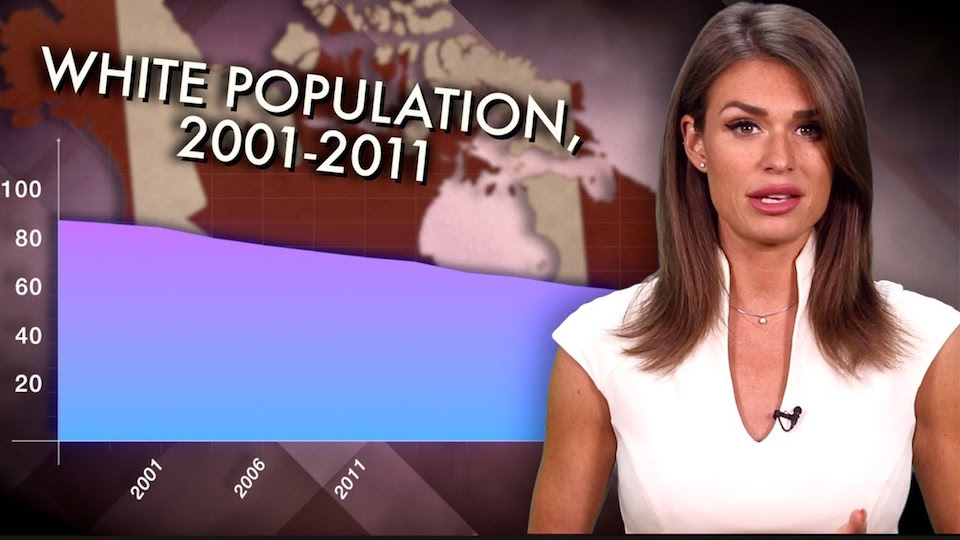
On January 25, 2018, Roosh V — real name Daryush Valizadeh, a rank misogynist and denizen of the so-called “manosphere” — hosted a live-streamed discussion of “tradthots” in the far right. A “tradthot” is a female internet personality who preaches “traditional” values and gender roles while advocating a #tradright lifestyle, but who fails to adhere to those standards herself, as the underlying motivation isn’t ideology, but rather, the allure of financial and reputational gain.
Gonzo journalist and conspiracy monger Laura Loomer, white nationalist podcaster Nicholas J. Fuentes, and far-right extremist Peter “Sweden” Imanuelsen were among the panel’s “special guests.” So, too, was Faith Goldy — the conservative commentator turned fringe-right propagandist turned neo-Nazi fellow traveller turned (for the moment) marginal candidate in Toronto’s mayoral election.
Pressed by Roosh on precisely where women in the far right belong, if she doesn’t think they should be in a “leadership-type role” (such as running for political office), Goldy suggested that rather than waste time on women — who, by #tradlife standards, should be at home dedicating themselves to the “4 Cs” of cooking, cleaning, children, and church — this was a time to “focus on male DNA… this is a time for strong men.”
https://twitter.com/FaithGoldy/status/1002925077267005441
“I, for one, have never fancied myself to be a thought leader,” Goldy stressed. “I’ve only seen myself as a propaganda arm, and I would hope that a lot of the [alt-right] women see themselves as such.” Describing herself as “one of the few tradthots who does not expose cleavage,” Goldy assured the panel she “closed down my Patreon account to send a message — I’m not here for beta bucks.”
Yet four months later, Goldy was crying persecution after Patreon notified her of her account’s termination due to violating its guidelines on hate speech.
Patreon cited Goldy’s “sincere” recitation of the Fourteen Words — the creed coined by David Lane, founding member of The Order, a far-right terrorist organization whose members murdered Jewish radio host Alan Berg after he insulted Lane on-air — during her hour-long chat with Scottish white supremacist Colin Robertson, known in the alt-right as “Millennial Woes.”
While speaking with Woes, Goldy gave full credit to Jared Taylor, Peter Brimelow, and Kevin Macdonald — all white supremacists and virulent anti-Semites — for providing the “robust intellectual backing” which drew her to the alt-right. “The VDare team had a lot to do with this,” she noted, before bragging of having “published a piece when I was back at The Rebel, called ‘White Genocide In Canada,’” which warned of a declining white demographic, and of “diversity” being “code for population replacement.”
https://twitter.com/FaithGoldy/status/987006234896322560
https://twitter.com/FaithGoldy/status/1002939327150804993
https://twitter.com/FaithGoldy/status/987002464267390976
“No one is going to save the white man except for himself,” Goldy went on, growing increasingly agitated, “and yet we’re like, ‘Keep on bringing the immigrants in’… if we don’t do anything about it, it’s only going to get worse. And I’ll be honest — as time goes on, in order to reverse this, the solutions are going to become more and more drastic, and I don’t want that.”
That coming solution? A race war.
And after favourably quoting Richard Spencer — at the time, still a highly influential neo-Nazi known for advocating a “peaceful ethnic cleansing” of nonwhites in America, and whose dream of establishing a white ethno-state she enthusiastically shares — Goldy recited Lane’s cri de coeur: “We must secure the existence of our people and a future for white children.”
Faith Goldy’s impulsive leap into Toronto’s municipal election is, to quote one former ideological ally who carefully tracked her descent into the darkest corners of the far right, “an exercise in profound selfishness.”
“Goldy knows the result that her actions and associations have — she jokes about it all the time,” wrote Jonathon Van Maren, a social conservative speaker and activist, in an imperfect but well-argued piece laying out the conservative case against Goldy’s candidacy. “By courting conservatives who have everything to lose by associating with her, she is proving beyond a shadow of a doubt that this mayoral run is a vanity exercise that is about her, and nobody else.”
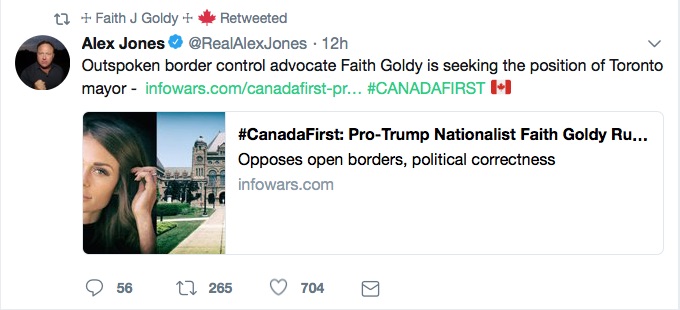
Despite the polished image she’s been trying to present of herself and her campaign — “We have the best volunteers don’t we folks!?” Goldy recently Tweeted along with a photo in which uniformed police officers happily posed — leaked Discord chat logs offer a hint of what one volunteer called a “pretty barebones operation that seemed to work entirely out of her car.”
“So these Sikhs are apparently pretty damn conservative, some of them told us outright that they were Rob and Doug Ford fans, which is why we were sent to this neighbourhood,” the volunteer wrote, admitting it was “pretty unnerving walking through a suburb that was all Indians. This wasn’t some public housing ghetto or anything, it was a typical looking North American suburb, but full of brown kids riding their bikes through the streets.”
“Diversity doesn’t seem bad if its a few blacks in some projects, or Asians in Chinatown,” the person continued, “but when you see them occupy an entire section of an otherwise normal looking city, it’s a different story… every white person should be made to walk through here.”
The campaign member then suggested fellow “goys” employ this sort of “eye-opening experience” to “help red-pill the masses” in everyday life. “Hopefully I get to [door-knock] in a white area next time though.”
As newsrooms weigh the merits of dedicating already scant resources to covering this marginal figure — one of 35 in the race for mayor — it’s worth noting the absence of pressure to do so with other insignificant candidates. That Goldy and her followers feel she is entitled to be considered equal to frontrunners John Tory and Jennifer Keesmaat doesn’t mean their delusions of grandeur need be indulged, and demands to treat this arguably bad-faith candidate as comparable to even second-tier personalities should be met with skepticism.
After all, it was Goldy herself who positioned the media as “the enemy,” and as with other demagogues who routinely demean the free press, impartial and unbiased reporting will always fail to satisfy her demands. Moreover, efforts to over-compensate for a feared perception of bias can result in uncritical amplification of harmful misinformation which, in the end, does more damage to the reputation of journalism than would the media holding a consistent standard and refusing to be bullied into engaging on the terms of those acting in bad faith.
Esteemed media veteran Ken Whyte, however, suggested the lack of attention paid to Goldy thus far was “antithetical to good journalism” and pointed to a lengthy Q&A by Graeme Gordon — a freelance journalist and frequent CANADALAND contributor — as “the most interesting and comprehensive thing I’ve seen on Toronto’s mayoralty campaign.” But when pressed by National Post columnist Chris Selley about what “story” was being missed, Whyte didn’t seem to have a meaningful answer.
And though Whyte characterizes Goldy as a “populist” candidate, Goldy rejected that very frame just weeks before she announced her intention to run for mayor on July 27.
https://twitter.com/FaithGoldy/status/1004380477157830656
“The zeitgeist that is sweeping us is not populism, it is [white] nationalism,” she told Infowars personality and host of The War Room, Jake Lloyd, in mid-June.
“We were never asked if we wanted to turn our proud, rich nations into essentially the boarding houses and battered women’s shelters for the third world,” she fumed. “And then we have the problem of fellow white people who are telling us that… all of this is antiquated and ‘white supremacy.’ People are starting to wake up … I think this is an exciting time to be a [white] nationalist and a right-winger.”
Whyte is correct, though, that there is a story to be found in Gordon’s piece — a cautionary tale for journalists on dealing with individuals who are, as described by New York Magazine senior editor Max Read, “so deeply disingenuous, and so completely uninterested in giving you any answer beyond the one that services their needs at that exact moment, that you are quite possibly doing your reader a disservice just by reporting on them.” [pdf]
Gordon wasn’t wrong to interview Goldy. His intent — to fill what he believed was a gap in campaign coverage — was sincere. His approach, however, was deeply flawed; it allowed her to control the discussion, offer evasive responses, and lie straight to his face with impunity.
Goldy’s shameless exploitation of Gordon’s offer is standard practise for extremists and agitators. And note that it was his reputation that suffered a (momentary) blow, not hers, despite his subsequent introspection versus her unbridled mendacity.
https://twitter.com/FaithGoldy/status/983374662204706816
Just as NPR handed marginal white-supremacist Jason Kessler a victory of sorts by allowing him to argue his abhorrently racist beliefs unchallenged on air — thus presenting white supremacy as mere political opinion, of equal merit to the social justice and civil rights causes to which it is opposed — Gordon’s choice to publish a verbatim Q&A offered Goldy a propaganda coup.
In May, Whitney Phillips, author of This Is Why We Can’t Have Nice Things: Mapping the Relationship Between Online Trolling and Internet Culture, published a comprehensive study into extremist manipulation of the media. One key observation was that when you allow such individuals to tell a story on their own terms, you grant them wide permission to edit the script.
She recommends that to maintain proper control over discussions, one must “avoid deferring to manipulators’ chosen language, explanations, or justifications.” To do this effectively, you must know your subject well. When dealing with Goldy, ask specific, detailed questions, and be prepared to both recognize and challenge dishonest responses; be equipped with the facts and knowledge required to firmly counter and correct misinformation in real time. Goldy has, time and again, proven herself a dishonest broker — her word is simply not one you can trust.
As evidenced in her exchange with Gordon, when asked an inconvenient question — “Do you still believe there is a white genocide taking place?” — Goldy will redirect, opting for a tangent to where she’s memorized her lines: “Do you want to know something interesting? I have never used the term ‘white genocide’ to discuss any sort of trend or single event anywhere… this is a propagated myth that has been manufactured in some paper and now it has caught on. I’ve never used the term anywhere to prove any point.”
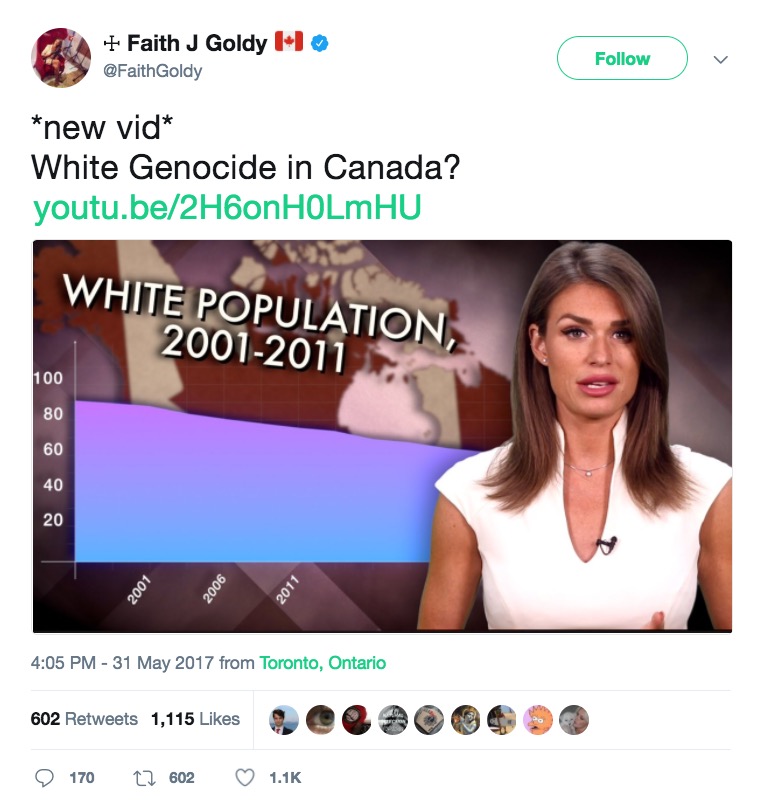
Goldy’s deliberate non-answer to the simple yes/no question of whether she believes there is a “white genocide” taking place — she does — is couched in demonstrable lies, confidently told, regarding her own embrace of that alt-right conspiracy theory, one notably common among neo-Nazis.
It should also be noted that on June 8, 2017, one week after publishing that dire warning at The Rebel, Goldy triumphantly bragged of “Toronto’s biggest morning show defend[ing] my white genocide piece & shut[ting] down those who try to silence me as ‘racist.’”
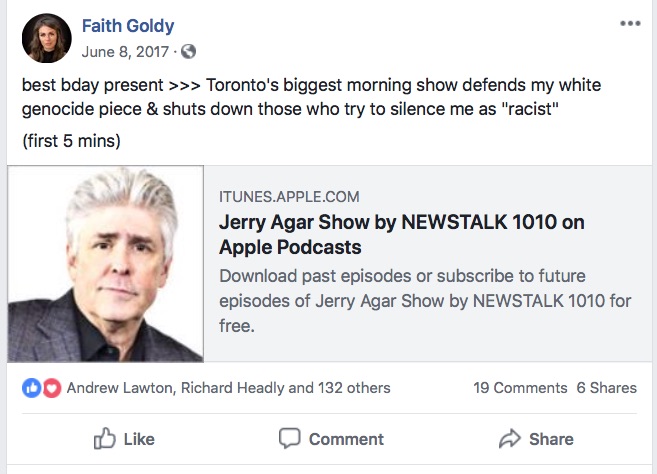
To justify his call for greater attention toward Goldy’s campaign, Gordon quoted an unnamed “top media figure who used to manage a newsroom” as advising that “she is more than a minor far-right media figure … her utility to the coverage of the campaign is she’s a perfect foil for Tory. He is so damn cautious and bland. She is pointed and extreme.”
What this respected and accomplished media figure doesn’t appreciate is that that approach is precisely how, over a two-year period, extremists were able to hijack news cycles and dominate the conversation to serve the interests of their respective hate groups — as well as then-candidate and now-President Donald Trump. It’s no coincidence that Trump’s administration is tied to — and in some areas, staffed by — anti-Muslim extremists, anti-immigration xenophobes, overt white nationalists, and fringe conspiracy theorists.
https://twitter.com/FaithGoldy/status/996413066551136256
As Phillips’s report on The Oxygen of Amplification made clear, bad actors “don’t have the numbers to steer the cultural conversation on their own.” They rely on the credibility and reach of traditional media for a key assist, as mainstream media’s “amplification makes particular stories, communities, and bad actors bigger — more visible, more influential — than they would have been otherwise.”
Meanwhile, the suggestion that Goldy is “more than a minor” far-right figure is simply not accurate. Both ardent supporters and fierce critics grant her far more significance than she maintains, inflating her profile in ways she alone never could. Visible as she may be, she is neither prominent nor influential among the post-Charlottesville alt-right. She is in many ways a perpetual status-seeker, a far-right performance artist akin to Milo Yiannopoulos, but without his knack for the shtick. An admitted propagandist and nothing more, her role is to nudge the mainstream right ever further to the fringe in hopes of resetting where the political centre lies.
She’s an agent provocateur who seeks chaos and courts outrage, and despite her lack of meaningful standing, her antics have resulted in real-world consequences. She whips up hysteria about immigrants, spreads lies about religious, racial, ethnic, and sexual minorities, and does so with gleeful enthusiasm, always at the expense of others.
https://twitter.com/FaithGoldy/status/961803768626139139
She will remain useful to the alt-right so long as she’s able to reliably draw oversized backlash, as this, in turn, nets desired amplification and mainstream media attention.
That’s not to suggest she should always be ignored. But when reporting on propagandists and other bad-faith actors — who will claim to have been misrepresented no matter how neutrally a story is presented — objectivity is crucial. And to objectively report on Goldy, one needs to know how to properly define where and for what she stands.
Is she truly a “Nazi,” as many critics allege?
After Charlottesville, J.M. Berger — a leading researcher, writer, and analyst on extremism — addressed the push to abandon what angry observers felt were euphemisms used to describe the presumed clear-cut “Nazis” of the alt-right.
“The alt-right encompasses a variety of right-wing and white supremacist movements,” Berger explained, “from conspiracists to the KKK … Nazis are only part of this movement, or more correctly neo-Nazis, since most of them aren’t German nationalists. Rejecting [other descriptors] might make you feel better,” he continued, “but it unproductively obscures the primary element that makes [the alt-right] work as a movement — its ability to unite disparate radical groups with differing beliefs and tactics into a single amorphous community that is capable of coordinated action.”
Berger is correct that, in carefully categorizing how people and ideologies fit in the broader scope — reserving the label of “neo-Nazi” for those to whom it truly applies, for instance — you’re not downplaying one element, but rather, you’re clearly defining another. And with this approach, you achieve deeper insights into each.
“If the alt-right movement consisted only of neo-Nazis,” Berger stressed, “we would not be talking about it.”
Without a doubt, Goldy is a neo-Nazi sympathizer and fellow traveller. She dabbles in anti-Semitism, flirts with fascism, and carefully toes the line on the “JQ” (“Jewish Question”). These aren’t insults or epithets, but factual, demonstrable observations.
https://twitter.com/mollycrabapple/status/1022989049668222976
That said, her endorsement of For My Legionaries — a book akin to Mein Kampf discussed in fascist forums, one you’ll find narrated at the Daily Stormer — during a chat with a fellow white nationalist, hinted at her shallow comprehension of the harder lines she espouses. Her swift walk-back of enthusiasm for the book fit a pattern of her blindly promoting extreme content in an effort to embellish her edge.
Goldy is a white nationalist who promotes white supremacist ideologies. She is, by her own admission, an “immigration-obsessed” member of the alt-right — some, like Goldy, have taken to calling themselves the “dissident right” — and she credits Charlottesville for “one of the most fantastic evolutions, from a personal standpoint… it helped me clarify what I think, what I believe, and how committed I am to truth, even in the face of whatever anyone wants to call me.”
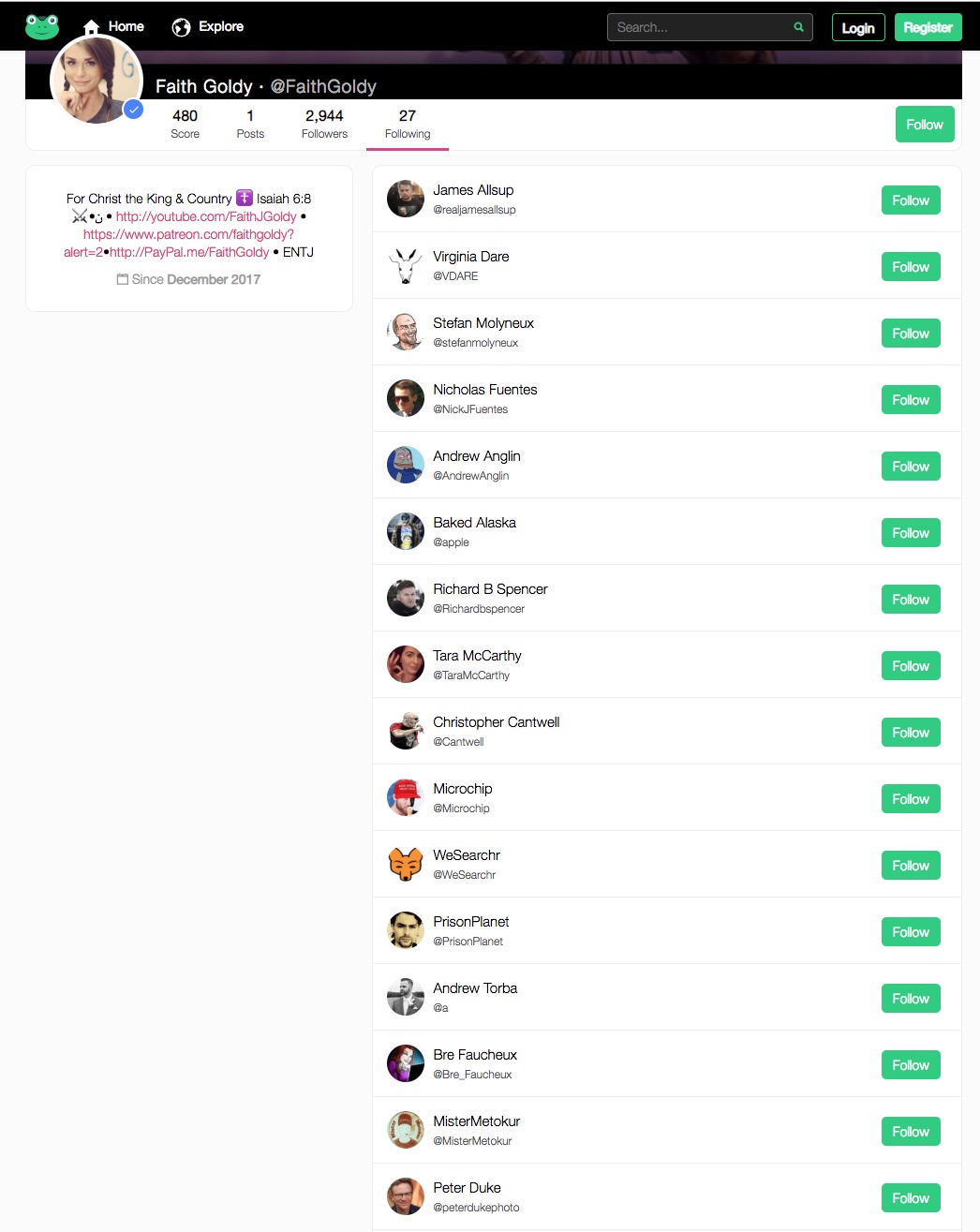
On the evening of August 12, 2017, hours after the violent “Unite the Right” rally in Charlottesville, Virginia, which ended in the death of Heather Heyer after white supremacist James Alex Fields Jr. plowed his car into the crowd of counter-protesters, a veritable who’s who of neo-Nazis gathered for an exclusive after-party to celebrate what they believed was their very own “Beer Hall Putsch.”
This tightly-controlled event, which required high-level vetting and security clearance on top of an invite to access, included the likes of Christopher Cantwell, the neo-Nazi featured in Vice’s documentary of the weekend who suggested “a lot more people are going to die before we’re done here, frankly”; “Charles Zeiger,” recently identified as Gabriel Sohier Chaput of Montreal, writer for the Daily Stormer, unapologetic fascist, and respected member of Canada’s fraternity of white supremacists; and “Eli Mosely,” recently identified as Elliott Kline, a prominent white nationalist central to organizing that Charlottesville weekend, who once bragged of working “in HR firing n*****s and spics all day” and fantasized about “listening to a kike’s scream while in the oven.”
Attendees were treated to a special live recording of The Krypto Report, an internet radio show hosted by Robert Warren Ray, an avowed white supremacist who writes for the Daily Stormer under the alias “Azzmador.”
They marvelled over the previous (Friday) night’s torchlight rally where, to chants of “Blood and soil” and “Jews will not replace us,” they stormed the University of Virginia campus, surrounded a small group of students encircling the statue of Thomas Jefferson, and met the students’ shouts of “No Nazis, no KKK, no fascist USA” with howls of “White Lives Matter.” That’s when, according to neo-Nazi podcaster and conspiracy theorist “Johnny Monoxide,” real name John Ramondetta, things turned violent. ”Some people got their heads busted… and we took the statue,” he told Azzmador proudly. “It was amazing.”
Saturday’s rally at Emancipation Park focused on a different monument. “They were trying to take down the statue,” Azzmador explained to Andrew Anglin, founder of the Daily Stormer, who wasn’t in Charlottesville but watched the day’s events via the Stormer’s livestream and joined the evening’s discussion remotely. “For most of us, even though that’s part of it, it became a whole lot more than that. It became about the destruction of white history and the removal of whites having power … to remove us completely, not only from existence, but from memory.”
Azzmador bragged how, before the “Battle of Charlottesville” erupted, “I went and I found Dr. David Duke, he gave a great talk about the Jews to the people watching on Daily Stormer. We got the crowd to shouting things like ‘Hitler did nothing wrong’ and ‘Gas the kikes, race war now.’ It was going along great.”
“It’s totally hilarious in a sense, how strong the parallels are between what we’re doing now and the movement in the 1960s,” Zeiger would suggest to the audience. “I mean, we’re getting kicked out of businesses, refused service, we’re advocating for civil rights for a certain racial group … and we’ve got normal people — ‘normies’ — who are fighting against that. Of course,” he noted, “we’re the reverse of what the people in the 1960s wanted. Because they were in favour of equality and all that, and the core of our message is more about hierarchy.”
That “hierarchy” being white racial supremacy.
If then-Rebel Media personality Faith Goldy — in attendance that night, by invitation — was troubled by things she heard through the hour preceding her spot on the broadcast, it certainly wasn’t enough to damper how “thrilled” she was to be part of the moment.
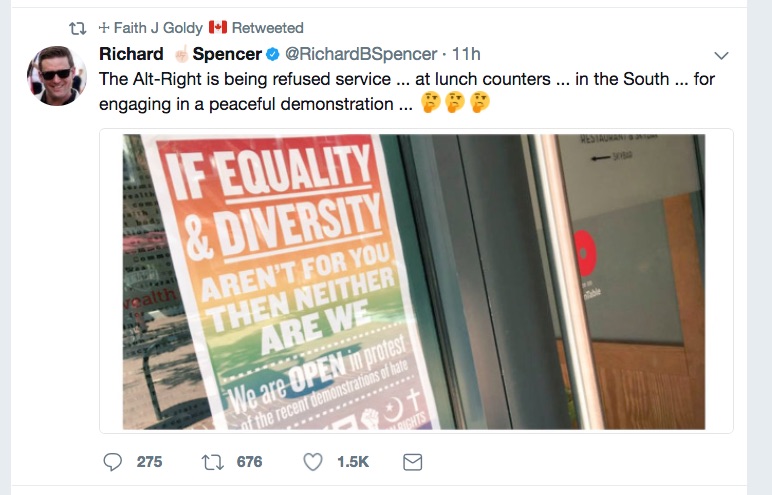
“I salute you all for doing this,” she said, adding tongue-in-cheek “not a ‘Roman salute,’ you guys.” (A “Roman salute” is essentially a Sieg Heil, but with the arm a bit lower. It is a fascist gesture.)
Goldy spoke of the “fellow Leafs” — the term for Canadian white nationalists — she met “from all over the place today,” winked at the frugality of her then-boss — a Jew — and indulged Azzmador’s seething distrust of what he calls the “lugenpresse.”
“Context is irrelevant in today’s media,” she charged. “We know that the cultural Marxists own the media, we know that they own academia, etc., and they’re pushing a particular narrative.”
Goldy’s strategic choice of words — “cultural Marxists” — was instructive. Those aware of the “JQ” know she was “naming the Jew” without naming the Jew. She deliberately spoke in code.
Days later, freshly unemployed and under intense scrutiny, Goldy tried damage control. “It has come to the public’s attention that I appeared on a podcast affiliated with the Daily Stormer while in Virginia,” she wrote on Facebook. “I made a poor decision that has had unintended negative personal and professional consequences on those I care about most.”
Those who took her at her word about her participation having simply been a “poor decision” — at the time, Toronto Sun columnist Joe Warmington asked people to “go easy” on the nearly 30-year-old woman because she was “a good kid” — may well have had reason to offer some benefit of the doubt. It’s entirely possible that, before Charlottesville, they’d paid little mind to Goldy’s ever-rightward trajectory.
Goldy has since made her sympathies abundantly clear, and the mainstream right should proceed with caution. Continuing to suggest she’s merely “a conservative voice” means embracing fascist, anti-Semitic, and white supremacist persuasions as part of respectable conservatism and reputable conservative discourse.
On CP24, Toronto Sun editor-in-chief Adrienne Batra refers to white nationalist Faith Goldy as a "conservative commentator."
— Jonathan Goldsbie (@goldsbie) July 27, 2018
Meanwhile, progressives and like-minded organizations should also be careful in how they deal with Goldy’s doomed candidacy.
Those calling on Tory or Keesmaat to boycott events in which she is included are, in effect, requesting that those who can most effectively and directly counter Goldy’s narrative while defining what Toronto stands for — tolerance, inclusivity, diversity — forgo that prime opportunity. Closing one’s ears to ignorance does not silence it, and rhetoric like hers, when left unchallenged, is what offers permission for people to act on their prejudice and paranoia. (Of course, to directly challenge her in such a substantive way would require her invitation to such events — which, as of now, no one seems inclined to offer.)
Goldy cannot defend her positions as ably or coherently as her critics fear — there’s a reason she keeps to friendly, sympathetic media and appearances. On the debate stage, she’d have no control over questions, direction, or format. Rather than cede to demands they boycott, her opponents should welcome the opportunity to firmly, unequivocally denounce her beliefs and discredit her candidacy.
And it’s crucial that her opponents not preemptively call for her exclusion from any event. Doing so will not only fuel the victim narrative on which she thrives, but will imply a weight of influence she does not carry.
There’s as much a threat in over-reacting to a political agitator as there is in not responding forcefully enough. Goldy isn’t as adept or clever as detractors seem to believe, and the illusion of the contrary has long worked to her advantage. Progressives would do well to take a breath, step back, and simply allow others to offer her rope.
Top image: The thumbnail from Goldy’s “White Genocide in Canada?” Rebel video, published on May 31, 2017, and since taken down.